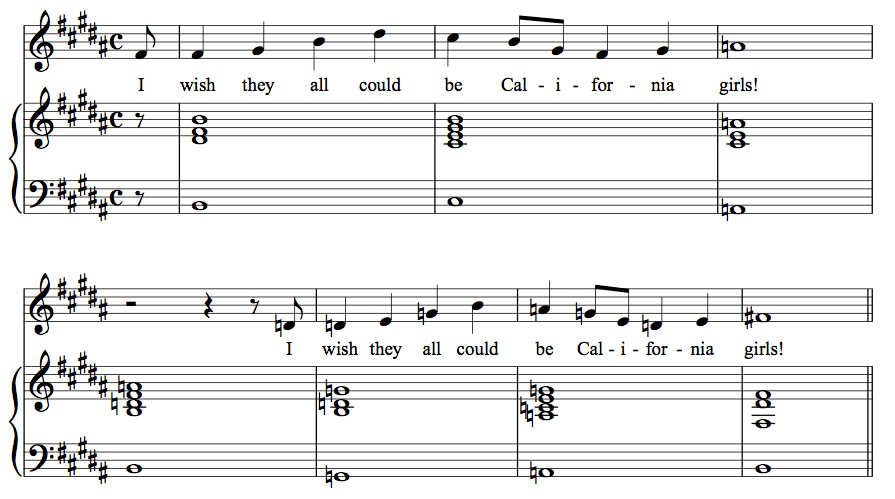Some tunes won’t get out of your ears. The chorus from the Beach Boys’ “California Girls” is one of them (click to listen, chorus starts at 1’00):

A lot of musical meaning is packed into these 8 bars (counting the pick up).
Those wary of music theory can skip down to “Getting Back Together.” Those wanting the full explanation, read on.
Complicated California Girls
On the most basic level, the chord structure is a chromatic sequence that transposes the I-ii7 relationship down from the tonic along the lowered 6th and 7th scale degrees and leads back to it the same way.
Wrinkle no. 1: The melody repeats twice over the same span that the core harmonic unit (I-ii7) sequences 3 times. This mismatch establishes a contrapuntal depth. By counterpoint, we mean the musical principle of simultaneous contrast, not the texture to which that word usually refers.[1. As Ernst Toch explains, this principle is more important than the texture: “Counterpoint (means) simply the point of contrast; and the only reason why such a simple explanation is nowhere to be found must be that it would make things too easy.” (in The Shaping Forces of Music,(New York: Dover, 1977), 134.)] Thus, this passage is contrapuntal in the sense that, instead of being about one thing (a melody and its chords), the passage is about two things (a melody that happens to mesh with a series of chords that are functioning on a different pattern than it).
Wrinkle no. 2: The melody and the harmony being in counterpoint causes us to interpret the harmony in two basic ways:
- On its face value, it’s a sequence.
- Relating to the melody, it’s a group of nested prolongations, the foundational one being 1–flat-6–1 (see fig. 2).

Wrinkle no. 3: The combination of these two interpretations gives rise to a third — that the harmony presents a series of tonicizations. Several different musical puns enable this interpretation.
In the first two sequence units, the second chord of the pair has a predominant function in relation to the one that precedes it and a dominant function in relation to the next unit of the sequence. The pun here is using the root-position mediant triad as dominant, echoing the dominant function of first-inversion mediant triads in Romantic harmony.
As the last unit returns to the home tonic, it creates a version of the flat-6–flat-7–1 cadence from the minor mode.[2. I remember Dr. Hicks at BYU calling this cadence the “Whitney Houston” cadence.] In contrast to the model version of that cadential figure, in this version the flat-7 supports a minor triad, in line with the rest of the sequence. Again, we hear the reference, but in an unusual version.
Wrinkle no. 4: Another music pun contributes to our hearing this sequence as a series of tonicizations. In the melody, when we first hear scale degrees 5 and 6 (m. 1 of fig. 1), they’re functioning as part of a pentatonic collection. In mm. 2-3, these get reinterpreted as scale degrees 6 and 7 in the major mode. In this role, F-sharp and G-sharp lead naturally to an arrival to the key of A (in this case, A major). That voice leading repeats itself in the harmony from the second to the third sequence unit as E–F-sharp–G.
Getting Back Together
Even if you cannot hear these wrinkles, you feel them as a restless energy.[3. Daniel Harrison gives a similar account of these features in “After Sundown: The Beach Boys’ Experimental Music.” Understanding Rock: Essays in Musical Analysis, ed. John Covach and Graeme M. Boone (Oxford, 1997): 37-38. He also adds that the vast harmonic turnover compressed into the expected 8 bars makes the chorus “reverberate far longer than the more prosaic progression of the verses.”] That a simple surface holds all these layers of double meaning makes the chorus absolutely beguiling. Your ear has something strong to hold on to, yet it cannot help but notice the sparkling interplay of the various relationships.[4. One aspect of the principle of counterpoint facilities this multitasking: namely, that notable events don’t happen simultaneously. Where this principle is obeyed, experienced listeners can sufficiently keep track of what’s going on simply by noting the entrances of important changes. Still, if they want to follow any one thread, they have to ignore the others, because the experience of multitasking is actually just rapid changes of singular focus.]
But there’s yet another layer to why this passage works so well: the musical setting of the text “I wish they all could be California girls!” is a psychologically compelling expression of longing.
The words “wish they” are set to the same pitches as the last two of syllables of “California.” These three words represent the essence of the singer’s desire, so their pairing by rhymed pitches is fitting.
So, musically and textually, you know what the singer wants. It’s easy to hear (1) the pitch connection between these syllables and (2) the pentatonic and diatonic interpretations of F-sharp and G-sharp. Yet by taking these non-functional pentatonic scale degrees and giving them the quintessential tonal function of tonicization — metaphorically taking the singer’s dreams and attempting to fulfill them in reality — the singer leads us out from our intended direction to a side path. We’re no longer in the key of B.
The inability to bridge this gap — to stay in the key of B and yet use F-sharp and G-sharp as scale degrees 6 and 7 — is a fantastic musical representation of longing, along the lines of Robert Hass: “Longing, we say, because desire is full / of endless distances.” We cannot have our cake and eat it, too;[5. It took me till I was 20 to figure out what this phrase meant (“. . . because if you eat your cake, it’s gone!”). I was a missionary visiting someone’s house at the time, and when I shared my startling insight, they responded along the lines of “Very good, Elder Sowa!” That playful condescension still makes me laugh.] they all can’t be California girls. And we know it.
Along with all the musical layers, Brian Wilson’s psychological pairing of music and text ensures that this otherwise lighthearted passage will remain in your mind for a long time.
Notes
Don’t Miss Next Week’s Post
Sign up to stay in the loop about my music—and ideas for your own composing!


